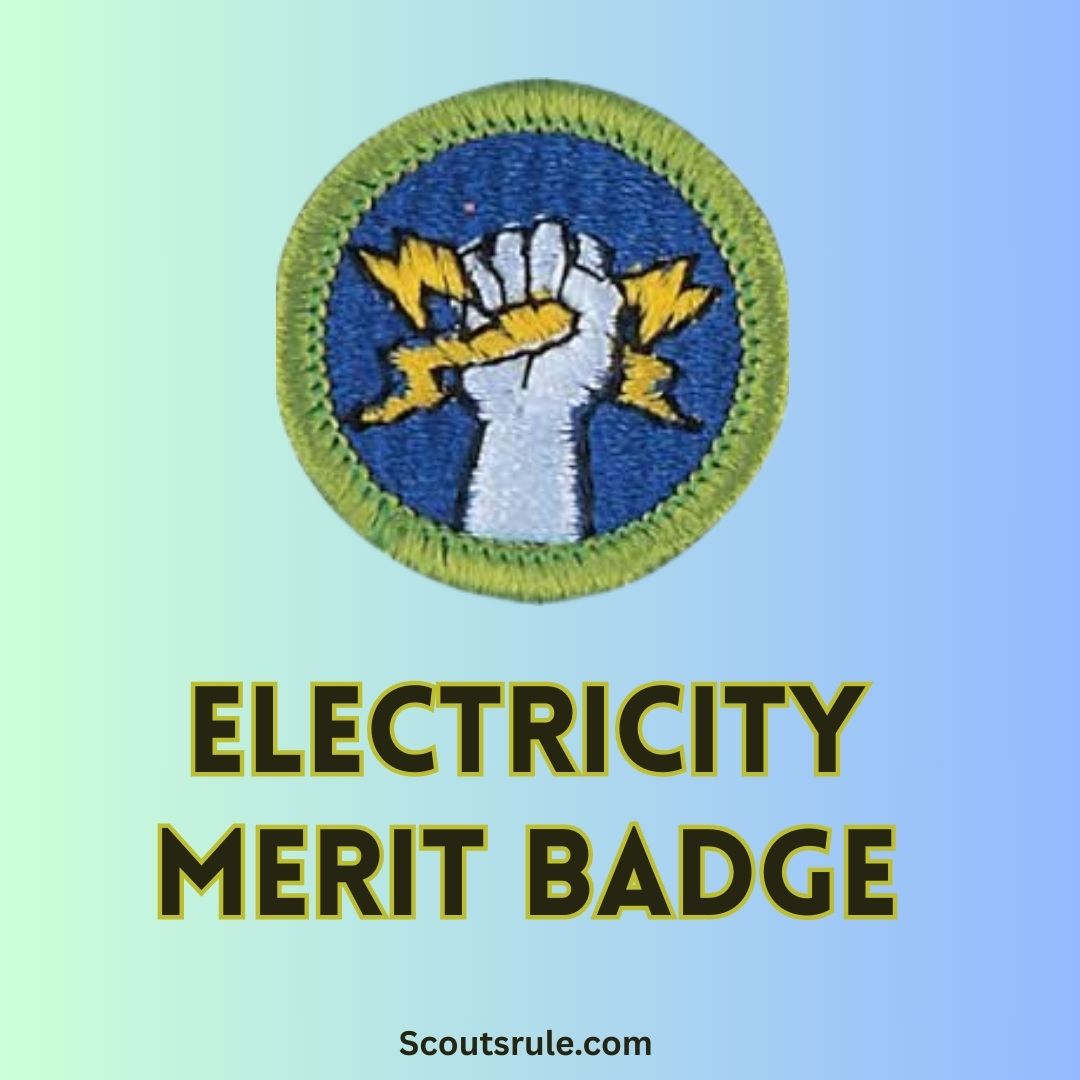
Electricity is a powerful force that lights our homes, powers our gadgets, and drives modern technology. Whether you’re learning how to rescue a person from a dangerous situation or constructing your own simple circuit, the Electricity Merit Badge gives Scouts the opportunity to explore both the wonder and the responsibility of working with electrical energy. This guide is divided into several sections, each focusing on a different aspect of the merit badge requirements, from emergency responses to building practical circuits and designing wiring diagrams.
Post Contents
- 1. Overview of the Electricity Merit Badge Requirements
- 2. Responding to Electrical Emergencies
- 3. Conducting a Home Electrical Safety Inspection
- 4. Building and Experimenting with Circuits
- 5. Understanding DC vs. AC and the Role of Circuit Protection
- 6. Creating Floor Plans and Wiring Diagrams
- 7. Practical Uses and Careers in Electricity
- 8. Conclusion and Final Thoughts
1. Overview of the Electricity Merit Badge Requirements
Before diving into experiments and projects, it’s important to understand the overall scope of the Electricity Merit Badge. The badge challenges you in several areas:
- Electrical Emergencies and Safety: Learn how to respond to accidents involving live wires, electrical shock, burns, and how to safely handle situations like electrical fires or storms.
- Home Electrical Safety Inspection: Gain practical knowledge by inspecting your home’s outlets, switches, power cords, circuit breaker panels, and GFCI outlets.
- Practical Circuit Construction: Build simple electromagnetic devices and circuits, including tasks such as making an electromagnet and connecting a buzzer, bell, or light with a battery through a switch or key.
- Understanding Electrical Concepts: Differentiate between direct current (DC) and alternating current (AC), understand fuse and circuit breaker functions, and explore the workings of electrical meters.
- Wiring Diagrams and Floor Plans: Develop skills by drawing wiring plans for a room or your entire home, identifying circuits, wiring routes, and safety features.
- Energy Awareness and Conservation: Learn how to read your electric meter and calculate energy costs, providing insight into energy use and conservation.
These diverse requirements are meant to help you not only get hands‑on with electrical devices but also understand how electricity impacts our daily lives and how to use it safely and responsibly.
2. Responding to Electrical Emergencies
One of the most important parts of earning the Electricity Merit Badge is knowing how to act safely when emergencies occur. Electrical accidents at home can be dangerous if not handled correctly. Here are the key emergency-related tasks and safety protocols you must know:
2.1 Turning Off the Power
Key Requirement:
Demonstrate how to shut off power to a specific circuit or the whole house in the event of an emergency.
- Circuit-Specific Shutdown: Locate the circuit breaker panel and identify the switch corresponding to the affected circuit. Practice turning off that circuit safely.
- Whole House Shutdown: Understand when it’s necessary to turn off the main circuit breaker. This might be crucial during widespread electrical hazards.
Using clear diagrams of a typical circuit breaker panel is highly recommended. You might draw a simple schematic showing the main breaker, individual breakers, and labels for each circuit (lighting, appliances, outlets).
2.2 Rescue Procedures in Case of Electrical Shock
Key Requirement:
Demonstrate how to safely rescue a person who is touching a live wire or is unconscious from an electrical shock.
- Avoid Direct Contact:
Always assume that both the victim and the rescuer are at risk. Use a non-conductive object—such as a wooden pole or a dry, non‑conductive piece of material—to separate the victim from the live wire. - First Aid for Electrical Shock:
Learn and practice basic first aid skills related to electrical shock. This includes checking for a pulse, performing CPR if necessary, and treating minor burns.
Be sure to consult first‑aid guidelines to accurately explain how to treat electrical burns.
2.3 What to Do During an Electrical Fire or Storm
Electrical Fire:
- If you suspect an electrical fire, do not try to extinguish it with water. Use a Class C fire extinguisher designed for electrical fires, or if safe, unplug the device causing the problem and then use appropriate fire suppression methods.
- Explain how circuit breakers or fuses protect your home by preventing overload and how these devices are reset.
Electrical Storm:
- In the event of an electrical storm, seek shelter indoors and stay away from windows.
- If you are caught outside, move away from tall objects like trees and metal structures that could attract lightning.
These steps ensure that you—and others around you—can respond during an emergency without unnecessarily endangering lives.
3. Conducting a Home Electrical Safety Inspection
Understanding the home’s electrical system is not only educational; it’s also a key preventative measure. An electrical safety inspection requires you to examine various components in your home.
3.1 Tools and Checklist
Gather the following tools:
- A flashlight or headlamp
- A voltage tester or multimeter for checking outlets
- A notepad and pen for recording your observations
- A camera (optional) for documenting any potential hazards
3.2 Inspection Steps
- Examine Outlets and Switches:
- Check that all outlets are in good condition with no signs of wear or discoloration.
- Ensure that switches operate smoothly and cause no sparks.
- Inspect Power Cords and Extension Cords:
- Look for frayed cords, exposed wiring, or damage that could lead to a short circuit.
- Ensure extension cords are not being used as permanent wiring and are in good repair.
- Survey Appliances and Devices:
- Verify that large appliances are properly grounded.
- Test devices like lamps and computers for safe operation.
- Evaluate the Circuit Breaker Panel:
- Check that the panel is clearly labeled and that no breakers are frequently tripping.
- Confirm that the main circuit breaker and individual breakers are easily accessible.
- Inspect Ground Fault Circuit Interrupter (GFCI) Outlets:
- GFCI outlets (usually found in kitchens, bathrooms, and outdoor areas) provide additional protection against electrical shock. Press the “test” button to ensure they are working as intended.
Using a checklist while inspecting these areas helps you keep track of any issues and suggests improvements to ensure safe electrical systems at home.
4. Building and Experimenting with Circuits
Practical projects bring theory to life. Several hands‑on projects are required for the Electricity Merit Badge. These projects allow you to see the flow of electricity, learn how energy is converted, and build simple devices that work on electrical principles.
4.1 Making a Simple Electromagnet
The electromagnet is one of the most popular experiments that demonstrates how electricity can create magnetism.
Materials:
- A large iron nail (approximately 3 inches long)
- Insulated copper wire (about 3–5 feet)
- A battery (usually a 9‑volt battery works well)
- Electrical tape
Steps:
- Wrap the Wire:
Begin by wrapping the insulated copper wire tightly around the nail. Leave a few inches of wire free at each end. - Strip the Insulation:
Use a wire stripper (or carefully cut and peel the insulation with scissors) to expose the copper at both ends of the wire. - Connect to the Battery:
Tape one end of the wire to the positive terminal of the battery and the other end to the negative terminal. - Test the Electromagnet:
Once connected, bring the nail near small metallic objects (like paper clips) to see the magnetic force in action. - Demonstrate Magnetic Attraction and Repulsion:
If possible, make adjustments to the number of wraps around the nail or vary the battery voltage, and observe how these changes affect the strength of the magnet.
This experiment teaches you the basics of electromagnetism, and it’s a great introduction to how motors and generators work.
4.2 Connecting a Buzzer, Bell, or Light with a Battery
This project helps you understand how to build a simple circuit while introducing the function of switches (or keys) in controlling electrical energy.
Materials:
- A small battery (AA or 9‑volt)
- A buzzer, small bell, or LED light
- A piece of insulated copper wire
- A simple switch or key (optional)
- Electrical tape
Steps:
- Construct the Circuit:
Connect one end of the battery to your electrical component (the buzzer, bell, or light) using a piece of wire. - Add a Switch (Optional):
To control the circuit, you can incorporate a small switch in line. The switch allows you to open or close the circuit. - Complete the Connection:
Connect the output from the component back to the battery’s negative terminal. - Test and Observe:
Close the switch (or connect the wires) and observe the component activate. For instance, the buzzer should sound, or the LED should light up.
This exercise not only reinforces the basics of how circuits operate, but also familiarizes you with the practical design considerations used in electrical wiring.
5. Understanding DC vs. AC and the Role of Circuit Protection
One of the essential learning outcomes is to distinguish between direct current (DC) and alternating current (AC) and to understand how circuit protection works.
5.1 Direct Current (DC) vs. Alternating Current (AC)
- Direct Current (DC):
- Flows steadily in one direction.
- Commonly found in batteries, small electronic devices, and many low‑voltage applications.
- Used in simple circuits like the electromagnet or LED circuit you built.
- Alternating Current (AC):
- Changes direction periodically.
- Supplied by wall outlets and used to power household appliances.
- The frequency for AC in the U.S. is typically 60 hertz.
Using diagrams that illustrate the flow of current in both DC and AC circuits can help you visualize the differences. For instance, a sine wave diagram helps to explain AC, while a straight line represents DC.
5.2 Understanding Fuses and Circuit Breakers
Safety in electrical systems comes in part from well‑designed circuit protection.
- Fuses:
A simple device that “blows” or melts when excessive current flows, thereby protecting the rest of the circuit. - Circuit Breakers:
These devices automatically switch off a circuit when they detect an overload or short circuit. They offer the advantage of being reset rather than replaced, unlike fuses.
Practical Demonstration:
- Create a simple circuit using a fuse holder and a fuse.
- Slowly increase the current (or simulate overloading) and observe how the fuse responds.
- This demonstration explains why fuses blow and how circuit breakers prevent electrical hazards.
6. Creating Floor Plans and Wiring Diagrams
One way to extend your learning is to apply your electrical knowledge to planning and visualizing an electrical system for a room or home.
6.1 Making a Floor Plan Wiring Diagram
A wiring diagram is a visual guide that shows:
- The location of outlets, switches, and fixtures
- The paths that electrical wiring takes from the circuit breaker panel to these devices
- The relationships between different electrical components
Steps to Create Your Own Wiring Diagram:
- Choose a Room:
Select a room in your home (such as your bedroom or living room) for which you’d like to create the diagram. - Measure and Draw a Floor Plan:
Sketch the room’s layout including windows, doors, and furniture placement. Make note of existing outlets, switches, and light fixtures. - Identify the Electrical Components:
Mark on your drawing where each outlet, switch, and fixture is located. - Trace the Wiring:
Draw lines representing electrical wiring from the circuit breaker to each component. Label the lines by circuit number if available. - Review and Discuss:
Using this diagram, discuss how electricity moves through the room. Consider factors such as distance from the circuit breaker, potential load on each line, and the safety measures required (for example, the placement of GFCI outlets in a kitchen or bathroom).
This activity demonstrates the importance of planning in electrical design and highlights how a clear layout can help in both installation and troubleshooting.
6.2 Understanding Your Electric Meter and Energy Costs
Another practical component involves learning to read your home’s electric meter and calculating energy cost. This real‑world application builds an awareness of energy consumption and efficiency.
- Meter Reading:
Learn the difference between analog and digital meters. Record your readings over a set period to track how much electricity is used. - Cost Calculations:
Using the recorded data and knowing your utility’s rate (cost per kilowatt‑hour), calculate the cost of your energy use for a month. - Discussion:
Evaluate how changes like switching to LED lighting or unplugging unused devices could lower your consumption and cost.
7. Practical Uses and Careers in Electricity
Beyond the hands‑on experiments, exploring the practical applications of electricity helps you understand its real‑world importance and potential career paths.
7.1 Everyday Electrical Applications
- Household Appliances:
Electric stoves, refrigerators, washers, and dryers all rely on circuits designed for safety and efficiency. - Communication Devices:
Telephones, computers, and smart devices use electronics that operate on both DC and AC, emphasizing the importance of understanding energy conversion. - Public Infrastructure:
Traffic lights, public transportation systems, and emergency services depend on well‑designed electrical systems that maintain safety and reliability.
7.2 Exploring Careers in Electricity
Earning your Electricity Merit Badge not only equips you with practical skills but may also inspire your future career choices. Here are several career paths related to electricity and electrical engineering:
- Electrical Engineer:
Electrical engineers design, test, and supervise the installation of electrical equipment. They work on power generation, transmission systems, and the development of new technologies for improved energy efficiency. - Electrician:
Electricians install, maintain, and repair electrical systems in homes, businesses, and industrial settings. This career requires hands‑on skill, attention to detail, and a deep understanding of electrical codes and safety practices. - Energy Auditor:
Specializing in analyzing energy use in buildings, energy auditors help reduce consumption and lower costs. Their work includes conducting audits, assessing insulation, and recommending improvements. - Renewable Energy Specialist:
With trends shifting toward sustainable energy sources, specialists in solar, wind, and geothermal technologies design systems to harness renewable energy effectively. - Safety Inspector:
These professionals ensure that electrical installations meet safety standards, work with regulators, and develop policies to prevent electrical hazards.
Understanding the wide spectrum of electrical careers helps you see the practical applications of the skills you gain through the merit badge projects and experiments.
7.3 Education and Training
- Academic Pathways:
A strong grounding in mathematics, physics, and technology is fundamental. Many college programs in electrical engineering, renewable energy, and related fields begin with the practical skills you develop as a Scout. - Certifications and Internships:
Hands‑on experience through internships, vocational training, and certification programs can pave the way for a successful career in the electrical or energy sectors. - Lifelong Learning:
Technologies change and safety standards evolve. Continuing education and staying updated through professional organizations will further enhance your career prospects.
8. Conclusion and Final Thoughts
Learning about electricity—its principles, safety practices, and applications—not only helps you earn your Electricity Merit Badge but also deepens your understanding of one of the fundamental forces that power modern life. Whether you’re building a simple electromagnet, mastering the art of wiring diagrams, or learning how to respond in an emergency, every step of the process prepares you for the real world.
Wrap-Up and Reflection
- Safety First:
Every experiment and project should start with a focus on safety. Understanding how to respond to electrical emergencies and inspect your home for hazards is not only a merit badge requirement but also an essential life skill. - Practical Experience:
Projects like constructing circuits and building an electromagnet provide tangible experiences that bring theoretical concepts to life. These hands‑on activities are fun, educational, and key to understanding how electricity works. - Planning for the Future:
As you learn to design wiring diagrams and conduct energy audits, you develop skills that can be applied in many future careers—whether as an electrician, engineer, or energy auditor. - Continuous Learning:
The world of electricity is ever‑evolving. By taking on the challenges of the Electricity Merit Badge, you become better prepared to tackle new innovations and safety challenges as technology advances.
Additional Resources and Next Steps
- Field Trips and Demonstrations:
Visit local power plants, attend science fairs, or arrange demonstrations with professionals in the field to see real‑world applications of electrical engineering. - Community Involvement:
Use your new knowledge to conduct safety workshops at your school or community center. Teach others about electrical safety, energy conservation, and the importance of responsible practices. - Advanced Projects:
Once you complete the merit badge requirements, consider exploring advanced projects such as building microcontroller‑based systems, experimenting with solar power conversion, or designing more complex circuits.
Every task, from understanding the nuances between AC and DC to mapping your home’s wiring, is a stepping stone toward becoming knowledgeable—not just in electrical science, but also in making a practical impact in everyday life.
Earning the Electricity Merit Badge empowers you with both technical know‑how and a responsible mindset. You are joining a community of Scouts and professionals who understand that electricity is much more than a force—it’s the foundation of modern existence and a field that always offers new challenges and innovations.
By exploring every facet of electricity—from safety emergencies to DIY circuits—you are poised not only to earn your merit badge but also to embrace a future where scientific curiosity and responsible practice go hand‑in‑hand. Let this guide serve as your roadmap, your reference manual, and your springboard into a deeper understanding of electrical science and its applications.
Good luck on your journey! And remember: Every circuit you build, every diagram you design, and every safety tip you master makes you one step closer to a future where you can confidently harness the power of electricity to innovate, protect, and inspire.
This comprehensive guide meets the Electricity Merit Badge requirements and provides you with detailed hands‑on projects, essential safety practices, and practical insights into the world of electrical systems. As you work through these lessons, you not only gain the technical skills required by the Boy Scouts but also build a foundation that could guide you toward an exciting career in the electrical or energy fields. Enjoy your exploration, stay safe, and let every experiment spark new enthusiasm for learning!

Hi, Robin here, A former lead Scout and here I share my inspiring stories about USA Scouts, leadership, adventure, how to guides and more.






